Swinging Sixties
Last updated| Part of the Counterculture of the 1960s | |
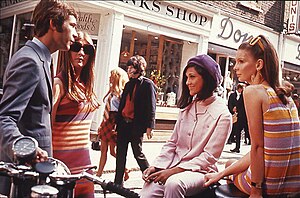 A scene from Carnaby Street, in London's West End, c. 1966 | |
| Date | 1960s |
|---|---|
| Location | United Kingdom |
| Also known as | Swinging London |
| Outcome | Changing social, political and cultural values |
The Swinging Sixties was a youth-driven cultural revolution that took place in the United Kingdom during the mid-to-late 1960s, emphasising modernity and fun-loving hedonism, with Swinging London denoted as its centre. [1] It saw a flourishing in art, music and fashion, and was symbolised by the city's "pop and fashion exports", such as the Beatles, as the multimedia leaders of the British Invasion of musical acts; the mod and psychedelic subcultures; Mary Quant's miniskirt designs; popular fashion models such as Twiggy and Jean Shrimpton; the iconic status of popular shopping areas such as London's King's Road, Kensington and Carnaby Street; the political activism of the anti-nuclear movement; and the sexual liberation movement. [1]
Contents
- Background
- Music
- Fashion and symbols
- Film
- Television
- See also
- References
- Bibliography
- External links
Music was an essential part of the revolution, with "the London sound" being regarded as including the Beatles, the Rolling Stones, the Who, the Kinks and the Small Faces, bands that were additionally the mainstay of pirate radio stations like Radio Caroline, Wonderful Radio London and Swinging Radio England. [2] Swinging London also reached British cinema, which according to the British Film Institute "saw a surge in formal experimentation, freedom of expression, colour, and comedy", with films that explored countercultural and satirical themes. [1] During this period, "creative types of all kinds gravitated to the capital, from artists and writers to magazine publishers, photographers, advertisers, film-makers and product designers". [2]
During the 1960s, London underwent a "metamorphosis from a gloomy, grimy post-war capital into a bright, shining epicentre of style". [2] The phenomenon has been agreed to have been caused by the large number of young people in the city—due to the baby boom of the 1950s—and the postwar economic boom. [2] Following the abolition of the national service for men in 1960, these young people enjoyed greater freedom and fewer responsibilities than their parents' generation, [2] and "[fanned] changes to social and sexual politics". [1]
Shaping the popular consciousness of aspirational Britain in the 1960s, the period was a West End-centred phenomenon regarded as happening among young, middle class people, and was often considered as "simply a diversion" by them. The swinging scene also served as a consumerist counterpart to the more overtly political and radical British underground of the same period. English cultural geographer Simon Rycroft wrote that "whilst it is important to acknowledge the exclusivity and the dissenting voices, it does not lessen the importance of Swinging London as a powerful moment of image making with very real material effect." [3]
Background
The Swinging Sixties was a youth movement emphasising the new and modern. It was a period of optimism and hedonism, and a cultural revolution. One catalyst was the recovery of the British economy after post-Second World War austerity, which lasted through much of the 1950s. [4]
"The Swinging City" was defined by Time magazine on the cover of its issue of 15 April 1966. [5] In a Piri Halasz article 'Great Britain: You Can Walk Across It on the Grass', [6] the magazine pronounced London the global hub of youthful creativity, hedonism and excitement: "In a decade dominated by youth, London has burst into bloom. It swings; it is the scene", [7] [8] and celebrated in the name of the pirate radio station, Swinging Radio England, that began shortly afterwards.
The term "swinging" in the sense of hip or fashionable had been used since the early 1960s, including by Norman Vaughan in his "swinging/dodgy" patter on Sunday Night at the London Palladium . In 1965, Diana Vreeland, editor of Vogue magazine, said that "London is the most swinging city in the world at the moment." [9] Later that year, the American singer Roger Miller had a hit record with "England Swings", which steps around the progressive youth culture (both musically and lyrically).
Music

Already heralded by Colin MacInnes' 1959 novel Absolute Beginners which captured London's emerging youth culture, [10] Swinging London was underway by the mid-1960s and included music by the Beatles, the Rolling Stones, the Kinks, the Who, Small Faces, the Animals, Dusty Springfield, Lulu, Cilla Black, Sandie Shaw and other artists from what was known in the US as the "British Invasion". [11] Psychedelic rock from artists such as Pink Floyd, Cream, Procol Harum, the Jimi Hendrix Experience and Traffic grew significantly in popularity.
Large venues, besides former music halls, included Hyde, Alexandra and Finsbury Parks, Clapham Common and the Empire Pool (which became Wembley Arena). This sort of music was heard in the United Kingdom on TV shows such as the BBC's Top of the Pops (where the Rolling Stones were the first band to perform with "I Wanna Be Your Man"), and ITV's Ready Steady Go! (which would feature Manfred Mann's "5-4-3-2-1" as its theme tune), on commercial radio stations such as Radio Luxembourg, Radio Caroline and Radio London, and from 1967 on BBC Radio One. [12] [13]
The Rolling Stones' 1966 album Aftermath has been cited by music scholars as a reflection of Swinging London. Ian MacDonald said, with the album the Stones were chronicling the phenomenon, while Philippe Margotin and Jean-Michel Guesdon called it "the soundtrack of Swinging London, a gift to hip young people". [14]
Fashion and symbols
During the Swinging Sixties, fashion and photography were featured in Queen magazine, which drew attention to fashion designer Mary Quant. [15] [16] Mod-related fashions such as the miniskirt stimulated fashionable London shopping areas such as Carnaby Street and King's Road, Chelsea. [17] [18] Vidal Sassoon created the bob cut hairstyle. [19]

The model Jean Shrimpton was another icon and one of the world's first supermodels. [20] She was the world's highest paid [21] and most photographed model [22] during this time. Shrimpton was called "The Face of the '60s", [23] in which she has been considered by many as "the symbol of Swinging London" [21] and the "embodiment of the 1960s". [24]
Like Pattie Boyd, the wife of Beatles guitarist George Harrison, Shrimpton gained international fame for her embodiment of the "British female 'look' – mini-skirt, long, straight hair and wide-eyed loveliness", characteristics that defined Western fashion following the arrival of the Beatles and other British Invasion acts in 1964. [25] Other popular models of the era included Veruschka, Peggy Moffitt and Penelope Tree. The model Twiggy has been called "the face of 1966" and "the Queen of Mod", a label she shared with, among others, Cathy McGowan, the host of the television rock show Ready Steady Go! from 1964 to 1966. [26]
The British flag, the Union Jack, became a symbol, assisted by events such as England's home victory in the 1966 World Cup. The Jaguar E-Type sports car was a British icon of the 1960s. [27]
In late 1965, photographer David Bailey sought to define Swinging London in a series of large photographic prints. [28] Compiled into a set titled Box of Pin-Ups, they were published on 21 November that year. [29] His subjects included actors Michael Caine and Terence Stamp; musicians John Lennon, Paul McCartney, Mick Jagger and five other pop stars; Brian Epstein, as one of four individuals representing music management; hairdresser Vidal Sassoon, ballet dancer Rudolf Nureyev, Ad Lib club manager Brian Morris, and the Kray twins; as well as leading figures in interior decoration, pop art, photography, fashion modelling, photographic design and creative advertising. [28]
Bailey's photographs reflected the rise of working-class artists, entertainers and entrepreneurs that characterised London during this period. Writing in his 1967 book The Young Meteors, journalist Jonathan Aitken described Box of Pin-Ups as "a Debrett of the new aristocracy". [30]
Film

The phenomenon was featured in many films of the time, including Darling (1965) starring Julie Christie, The Pleasure Girls (1965), [31] The Knack ...and How to Get It (1965), Michelangelo Antonioni's Blowup (1966), Alfie (1966) starring Michael Caine, Morgan: A Suitable Case for Treatment (1966), Georgy Girl (1966), Kaleidoscope (1966), The Sandwich Man (1966), The Jokers (1967), Casino Royale (1967) starring Peter Sellers, Smashing Time (1967), To Sir, with Love (1967), Bedazzled (1967) starring Dudley Moore and Peter Cook, Poor Cow (1967), I'll Never Forget What's'isname (1967), Up the Junction (1968), Joanna (1968), Otley (1968), The Strange Affair (1968), Baby Love (1968), The Magic Christian (1969), The Touchables (1968), Les Bicyclettes de Belsize (1969), Two Gentlemen Sharing (1969), Performance (1970), and Deep End (1970). [32]
The comedy films Austin Powers: International Man of Mystery (1997) and Austin Powers: The Spy Who Shagged Me (1999), written by and starring Mike Myers, resurrected the imagery of the Swinging London scene (but were filmed in Hollywood), as did the 2009 film The Boat That Rocked . [27]
Television
- The ITV spy-fi series The Avengers (1961–1969), particularly after it began broadcasting in colour, revelled in its Swinging Sixties setting. [33] In the 1967 episode "Dead Man's Treasure", Emma Peel (played by Diana Rigg) arrives in the archetypal English village of Swingingdale, dubbing it "not very swinging".
- In the episode "Beauty Is an Ugly Word" (1966) of BBC's Adam Adamant Lives! , Adamant (Gerald Harper), an Edwardian adventurer suspended in time since 1902, was told, "This is London, 1966 – the swinging city." [34]
- The BBC show Take Three Girls (1969) is noted for Liza Goddard's first starring role, an evocative folk-rock theme song ("Light Flight" by Pentangle), a West Kensington location, and scenes in which the heroines were shown dressing or undressing. [35]
- "Jigsaw Man", a 1968 episode of the detective series Man in a Suitcase , opened with the announcement: "This is London … Swinging London." [36]
See also
- 1960s in fashion
- Cool Britannia, a Britain-wide phenomenon in the 1990s and 2000s.
- Freakbeat
- Timeline of London 1940s–1990s
- UK underground – London 1960s counter-culture, or underground, scene
- Yé-yé
- Youthquake (movement)
Related Research Articles

The Rolling Stones are an English rock band formed in London in 1962. Active across seven decades, they are one of the most popular and enduring bands of the rock era. In the early 1960s, the band pioneered the gritty, rhythmically driven sound that came to define hard rock. Their first stable line-up consisted of vocalist Mick Jagger, guitarist Keith Richards, multi-instrumentalist Brian Jones, bassist Bill Wyman, and drummer Charlie Watts. During their early years, Jones was the primary leader of the band. After Andrew Loog Oldham became the group's manager in 1963, he encouraged them to write their own songs. The Jagger–Richards partnership became the band's primary songwriting and creative force.
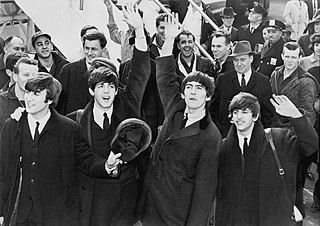
The British Invasion was a cultural phenomenon of the mid-1960s, when rock and pop music acts from the United Kingdom and other aspects of British culture became popular in the United States with significant influence on the rising "counterculture" on both sides of the Atlantic Ocean. UK pop and rock groups such as the Beatles, the Rolling Stones, the Who, the Kinks, the Zombies, Small Faces, the Dave Clark Five, The Spencer Davis Group, Herman's Hermits, the Hollies, the Animals, Gerry and the Pacemakers, the Searchers, the Yardbirds, Them, and Manfred Mann, as well as solo singers such as Dusty Springfield, Cilla Black, Petula Clark, Tom Jones and Donovan, were at the forefront of the "invasion".

"Street Fighting Man" is a song by the English rock band the Rolling Stones, written by the songwriting team of Mick Jagger and Keith Richards. Considered one of the band's most popular and most controversial songs, it features Indian instrumentation contributed by Brian Jones, which has led to it being characterized as a raga rock song. It also features controversial and ambiguous lyrics about armed revolution. In the United States, it was released as a single in August 1968, while it was not released in the United Kingdom until four months later on the Beggars Banquet album, where it opened side two. The B-side of the American single featured "No Expectations", considered one of the final Stones tracks in which founding member Jones played a significant role in its construction.

Carnaby Street is a pedestrianised shopping street in Soho in the City of Westminster, Central London. Close to Oxford Street and Regent Street, it is home to fashion and lifestyle retailers, including many independent fashion boutiques.
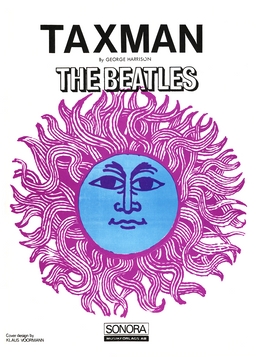
"Taxman" is a song by the English rock band the Beatles from their 1966 album Revolver. Written by the group's lead guitarist, George Harrison, with some lyrical assistance from John Lennon, it protests against the higher level of progressive tax imposed in the United Kingdom by the Labour government of Harold Wilson, which saw the Beatles paying over 90 per cent of their earnings to the Treasury. The song was selected as the album's opening track and contributed to Harrison's emergence as a songwriter beside the dominant Lennon–McCartney partnership. It was the group's first topical song and the first political statement they had made in their music.

Aftermath is a studio album by the English rock band the Rolling Stones. The group recorded the album at RCA Studios in California in December 1965 and March 1966, during breaks between their international tours. It was released in the United Kingdom on 15 April 1966 by Decca Records and in the United States in late June or early July 1966 by London Records. It is the band's fourth British and sixth American studio album, and closely follows a series of international hit singles that helped bring the Stones newfound wealth and fame rivalling that of their contemporaries the Beatles.
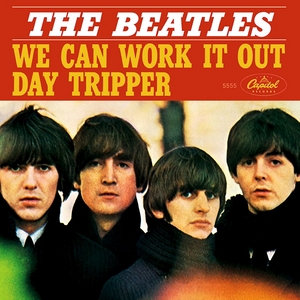
"Day Tripper" is a song by the English rock band the Beatles that was released as a double A-side single with "We Can Work It Out" in December 1965. The song was written primarily by John Lennon with some contributions from Paul McCartney and was credited to the Lennon–McCartney partnership. Both songs were recorded during the sessions for the band's Rubber Soul album. The single topped charts in Britain, Ireland, the Netherlands and Norway. In the United States, "Day Tripper" peaked at number five on the Billboard Hot 100 chart and "We Can Work It Out" held the top position.

Got Live If You Want It! is an album of mostly live recordings by the English rock band the Rolling Stones. It was released in November 1966 by London Records in the United States. With its release, the label attempted to fill a marketing gap between the Stones' studio albums and capitalise on their popularity in the US market, which was heightened that year by a famously successful North American concert tour supporting their hit album Aftermath (1966).
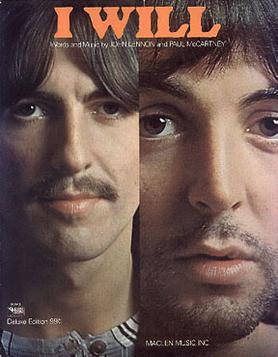
"I Will" is a song by the English rock band the Beatles, from their 1968 double album The Beatles. It was written by Paul McCartney and features him on lead vocal, guitar, and "vocal bass".
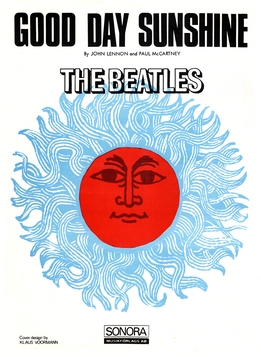
"Good Day Sunshine" is a song by the English rock band the Beatles from their 1966 album Revolver. It was written mainly by Paul McCartney and credited to the Lennon–McCartney partnership. McCartney intended it as a song in the style of the Lovin' Spoonful's contemporaneous hit single "Daydream". The recording includes multiple pianos played in the barrelhouse style and evokes a vaudevillian mood.

"The Night Before" is a song by the English rock band the Beatles from their 1965 film Help! and soundtrack album of the same name. It was written primarily by Paul McCartney and credited to the Lennon–McCartney partnership. Described as a pop rock or rock and roll song, its lyrics reflect on the singer's last night with his lover before being abandoned.

"Magical Mystery Tour" is a song by the English rock band the Beatles and the title track to the December 1967 television film of the same name. It was released on the band's Magical Mystery Tour soundtrack record, which was a double EP in Britain and most markets but an album in America, where Capitol Records supplemented the new songs with tracks issued on the Beatles' 1967 singles. The song was written primarily by Paul McCartney and credited to the Lennon–McCartney partnership.

"Ruby Tuesday" is a song recorded by the Rolling Stones in 1966, released in January 1967. The song became the band's fourth number-one hit in the United States and reached number three in the United Kingdom as a double A-side with "Let's Spend the Night Together". The song was included in the American version of Between the Buttons.
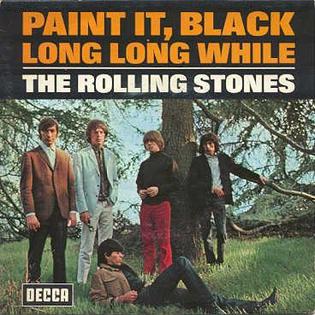
"Paint It Black" is a song by the English rock band the Rolling Stones. A product of the songwriting partnership of Mick Jagger and Keith Richards, it is a raga rock song with Indian, Middle Eastern and Eastern European influences and lyrics about grief and loss. London Records released the song as a single on 7 May 1966 in the United States, and Decca Records released it on 13 May in the United Kingdom. Two months later, London Records included it as the opening track on the American version of the band's 1966 studio album Aftermath, though it is not on the original UK release.

"We Love You" is a song by the English rock band the Rolling Stones that was written by Mick Jagger and Keith Richards. Their first new release of the summer of 1967, it was first released as a single on 18 August in the United Kingdom, with "Dandelion" as the B-side. The song peaked at number eight in Britain and number 50 in the United States, where "Dandelion" was promoted as the A-side and peaked at number 14.

"She's a Rainbow" is a song by the Rolling Stones and was featured on their 1967 album Their Satanic Majesties Request. It has been called "the prettiest and most uncharacteristic song" that Mick Jagger and Keith Richards wrote for the Stones, although somewhat ambiguous in intention.

"Mother's Little Helper" is a song by the English rock band the Rolling Stones. A product of Mick Jagger and Keith Richards' songwriting partnership, it is a folk rock song with Eastern influences. Its lyrics deal with the popularity of prescribed tranquilisers like Valium among housewives and the potential hazards of overdose or addiction. Recorded in December 1965, it was first released in the United Kingdom as the opening track of the band's April 1966 album, Aftermath. In the United States, it was omitted from the album and instead issued as a single in July 1966 during the band's fifth American tour. The Rolling Stones' twelfth US single, "Mother's Little Helper" spent nine weeks on the US Billboard Hot 100, peaking at No. 8, and it reached No. 4 on both Record World and Cash Box's charts.
Yesterday's Papers is a song by the Rolling Stones from their 1967 album, Between the Buttons. It was the first song that Mick Jagger wrote by himself for the group. It appears as the opening track on the UK version of the album and on the US version as the second track.

Lady Jane was the first women's fashion boutique on London's Carnaby Street. It was opened by Henry Moss and his partner Harry Fox in April 1966 and was seen as a counterpart to Warren Gold's Lord John chain.
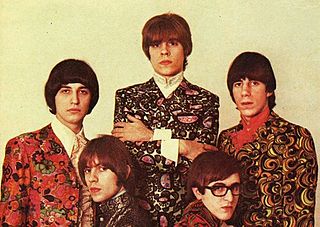
The peacock revolution was a fashion movement which took place between the late 1950s and mid–1970s, mostly in the United Kingdom. Mostly based around men incorporating feminine fashion elements such as floral prints, bright colours and complex patterns, the movement also saw the embracing of elements of fashions from Africa, Asia, the late 17th century and the queer community. The movement began around the late 1950s when John Stephen began opening boutiques on Carnaby Street, London, which advertised flamboyant and queer fashions to the mod subculture. Entering the mainstream by the mid-1960s through the designs of Michael Fish, it was embraced by popular rock acts including the Beatles, the Rolling Stones and Small Faces. By the beginning of the 1970s, it had begun to decline due to popular fashion returning to a more conservative style.
References
- 1 2 3 4 Wakefield, Thirza (15 July 2014). "10 great films set in the swinging 60s". British Film Institute . Retrieved 5 November 2016.
- 1 2 3 4 5 "Swinging 60s – Capital of Cool". History. AETN UK. Archived from the original on 6 November 2016. Retrieved 5 November 2016.
- ↑ Rycroft, Simon (2016). "Mapping Swinging London". Swinging City: A Cultural Geography of London 1950–1974. Routledge. p. 87. ISBN 978-1-317-04734-6.
- ↑ "Going Platinum: The UK's 70 years of change". HSBC. Retrieved 11 October 2022.
1950s and 1960s: the post-war investment boom. When the Queen came to the throne, the UK economy was still in its post-war boom period
- ↑ "TIME Magazine Cover: London – Apr. 15, 1966". TIME.com. Retrieved 25 January 2019.
- ↑ Rycroft, Simon (2012). Swinging City: A Cultural Geography of London 1950–1974. Ashgate Publishing, Ltd. ISBN 978-1-4094-8887-3 . Retrieved 26 January 2019.
- ↑ "The Diamond Decades: The 1960s" . The Daily Telegraph. 10 November 2016. Archived from the original on 12 January 2022.
- ↑ most famous (if not the first) identification of Swinging London Gilbert, David (2006) "'The Youngest Legend in History': Cultures of Consumption and the Mythologies of Swinging London" The London Journal 31(1): pp. 1–14, page 3, doi : 10.1179/174963206X113089
- ↑ Quoted by John, Weekend Telegraph, 16 April 1965; and in Pearson, Lynn (2007) "Roughcast textures with cosmic overtones: a survey of British murals, 1945–80" Decorative Arts Society Journal 31: pp. 116–37
- ↑ "Absolute MacInnes: British identity and society". The Guardian. Retrieved 2 October 2022.
- ↑ Ira A. Robbins. "British Invasion (music) - Britannica Online Encyclopedia". Britannica.com. Retrieved 2 October 2022.
- ↑ "BBC says fond farewell to Top of the Pops". BBC. Archived from the original on 20 November 2018. Retrieved 2 September 2022.
- ↑ Roberts, David (1998). Guinness Rockopedia (1st ed.). London: Guinness Publishing Ltd. p. 258. ISBN 0-85112-072-5.
- ↑ Norman 2001 , p. 197; Moon 2004 , p. 697; MacDonald 2002; Margotin & Guesdon 2016 , p. 136.
- ↑ Barry Miles (2009). The British Invasion: The Music, the Times, the Era. Sterling. p. 203. ISBN 978-1-4027-6976-4.
- ↑ Ros Horton, Sally Simmons (2007). Women Who Changed the World. Quercus. p. 170. ISBN 978-1-84724-026-2.
- ↑ Armstrong, Lisa (17 February 2012). "Mary Quant: 'You have to work at staying slim—but it's worth it'". The Telegraph. Retrieved 17 October 2012.
- ↑ DelaHaye, Amy (2010). Steele, Valerie (ed.). The Berg Companion to Fashion. Oxford: Berg. pp. 586–588. ISBN 978-1-84788-563-0.
- ↑ "Telegraph obituary". The Daily Telegraph. 10 May 2012. Retrieved 16 August 2022.
- ↑ Burgess, Anya (10 May 2004). "Small is still beautiful". Daily Post.
- 1 2 "The Girl Behind The World's Most Beautiful Face". Family Weekly. 8 February 1967.
- ↑ Cloud, Barbara (11 June 1967). "Most Photographed Model Reticent About Her Role". The Pittsburgh Press.
- ↑ "Jean Shrimpton, the Famed Face of the '60s, Sits Before Her Svengali's Camera One More Time". 30 May 1977.
- ↑ Patrick, Kate (21 May 2005). "New Model Army". Scotsman.com News.
- ↑ Hibbert, Tom (1982). "Britain invades the world: Mid-Sixties British Music". The History of Rock . Available at Rock's Backpages (subscription required).
- ↑ Fowler, David (2008) Youth Culture in Modern Britain, C.1920–c.1970: From Ivory Tower to Global Movement – A New History p. 134. Palgrave Macmillan, 2008
- 1 2 John Storey (2010). "Culture and Power in Cultural Studies: The Politics of Signification". p. 60. Edinburgh University Press
- 1 2 Brown, Peter; Gaines, Steven (2002) [1983]. The Love You Make: An Insider's Story of the Beatles. New York, NY: New American Library. p. 120. ISBN 978-0-451-20735-7.
- ↑ Bray 2014, p. xii.
- ↑ Bray 2014, pp. 252–53.
- ↑ Mitchell, Neil (2011). World Film Locations: London. Intellect Books. p. 66. ISBN 978-1-84150-484-1.
- ↑ "10 great films set in the swinging 60s". BFI.org. 10 November 2016.
- ↑ "Patrick Macnee: five things you didn't know about Avengers star", The Week, 26 June 2015. Retrieved 24 October 2015.
- ↑ Dominic Sandbrook (2015). White Heat: A History of Britain in the Swinging Sixties. Hatchett UK
- ↑ Falk, Quentin; Falk, Ben (2005). Television's Strangest Moments: Extraordinary But True Tales from the History of Television. Franz Steiner Verlag. p. 78. ISBN 978-1-86105-874-4.
- ↑ "Man in a Suitcase (1967–68)". CTVA. Retrieved 10 November 2016
Bibliography
- Beard, Chris (Joe) (2014). Taking the Purple: The Extraordinary Story of The Purple Gang – Granny Takes a Trip … and All That. print ISBN 978-0-9928671-0-2 or online in Kindle format https://www.amazon.com/dp/B00KLOEOIO ISBN 978-0-9928671-1-9.
- Bray, Christopher (2014). 1965: The Year Modern Britain was Born. London: Simon & Schuster. ISBN 978-1-84983-387-5.
- Levin, Bernard (1970). The Pendulum Years. Jonathan Cape. ISBN 978-0-224-61963-9.
- MacDonald, Ian (November 2002). "The Rolling Stones: Play With Fire". Uncut . Available at Rock's Backpages (subscription required)
- Margotin, Philippe; Guesdon, Jean-Michel (2016). The Rolling Stones All the Songs: The Story Behind Every Track. Running Press. ISBN 978-0316317733.
- Melly, George (1970). Revolt into Style . Allen Lane. ISBN 978-0-7139-0166-5.
- Moon, Tom (2004). "The Rolling Stones". In Brackett, Nathan; Hoard, Christian (eds.). The New Rolling Stone Album Guide . London: Fireside. ISBN 0-7432-0169-8.
- Norman, Philip (2001). The Stones. London: Sidgwick & Jackson. ISBN 0-283-07277-6.
- Nuttall, Jeff (1968). Bomb Culture. MacGibbon & Kee. ISBN 978-0-261-62617-1.
- Sandbrook, Dominic (2006). White Heat: A history of Britain in the swinging sixties. Little, Brown. ISBN 978-0-316-72452-4.
- Sandbrook, Dominic (2005). Never Had It So Good: A history of Britain from Suez to the Beatles. Little, Brown. ISBN 978-0-316-86083-3.
- Salter, Tom (1970). Carnaby Street. Margaret and Jack Hobbs, Walton-on-Thames, Surrey, England. ISBN 978-0-85138-009-4.
External links
Text is available under the CC BY-SA 4.0 license; additional terms may apply.
Images, videos and audio are available under their respective licenses.